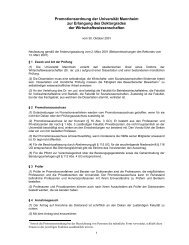The returns to cognitive and non-cognitive abilities in Germany
The returns to cognitive and non-cognitive abilities in Germany
The returns to cognitive and non-cognitive abilities in Germany
Create successful ePaper yourself
Turn your PDF publications into a flip-book with our unique Google optimized e-Paper software.
measur<strong>in</strong>g the underly<strong>in</strong>g scale. With the alphas at h<strong>and</strong>, we estimate an additional set of<br />
regressions <strong>to</strong> correct for the measurement error problem by impos<strong>in</strong>g the reliability ratios <strong>in</strong><br />
order <strong>to</strong> adjust both parameter estimates <strong>and</strong> st<strong>and</strong>ard errors (Kmenta, 1997, pp. 352-357).<br />
Panel approach<br />
Although our <strong>in</strong>dica<strong>to</strong>rs of personality <strong>and</strong> cognition are taken from the 2005 <strong>and</strong><br />
2006 waves of the SOEP, it is still possible <strong>to</strong> exploit the longitud<strong>in</strong>al structure of the survey<br />
<strong>to</strong> further account for <strong>in</strong>dividual specific heterogeneity. S<strong>in</strong>ce we assume that the<br />
‘residualized’ <strong>in</strong>dica<strong>to</strong>rs of cognition <strong>and</strong> personality are constant over time, we match the<br />
cross-sectional <strong>in</strong>dica<strong>to</strong>rs <strong>to</strong> all preced<strong>in</strong>g waves <strong>to</strong> be able <strong>to</strong> exploit the longitud<strong>in</strong>al<br />
structure of the SOEP. While this excludes the use of fixed effects estimation, we estimate<br />
r<strong>and</strong>om effects (RE) regressions <strong>in</strong> addition <strong>to</strong> the pooled OLS estima<strong>to</strong>r <strong>to</strong> account for<br />
unobservable heterogeneity. However, this comes at the price of assum<strong>in</strong>g that <strong>in</strong>dividual<br />
specific heterogeneity is uncorrelated with cognition, personality, <strong>and</strong> the vec<strong>to</strong>r of control<br />
variables which might not be appropriate. As alternative <strong>to</strong> this ‘all-or-noth<strong>in</strong>g’ choice<br />
between r<strong>and</strong>om effects or fixed effects models, we also employ the Hausman-Taylor IV<br />
(HTIV) estima<strong>to</strong>r (Hausman <strong>and</strong> Taylor, 1981), which allows <strong>in</strong>clud<strong>in</strong>g time-<strong>in</strong>variant<br />
covariates that are either exogenous or endogenous. 13 <strong>The</strong> underly<strong>in</strong>g model <strong>in</strong> the HTIV is<br />
as follows:<br />
= + ′ + ′ + ′ + ′ + + (2)<br />
ln y it<br />
β0 x1, it<br />
β1 x2, it<br />
β2 z1 i<br />
γ1 z2 i<br />
γ2<br />
α i<br />
u it<br />
where x<br />
1,it<br />
is a vec<strong>to</strong>r of time vary<strong>in</strong>g variables which are assumed <strong>to</strong> be uncorrelated with<br />
the <strong>in</strong>dividual effects α<br />
i<br />
, x<br />
2,it<br />
is a vec<strong>to</strong>r of variables which also are time vary<strong>in</strong>g but need<br />
not be uncorrelated with α<br />
i<br />
. z1i<br />
<strong>and</strong> z2i<br />
are vec<strong>to</strong>rs of time-<strong>in</strong>variant variables that aga<strong>in</strong> are<br />
assumed <strong>to</strong> be uncorrelated or which might be correlated with the <strong>in</strong>dividual specific effects,<br />
17















